
When asked about stinging nettle, most folks have a story involving a brush with this prickly plant that left them howling in pain and itching for days.
From others, you’ll hear groans about how this ‘weed’ is taking over their backyard, and it’s impossible to get rid of. Foragers will tell you it’s one of their favorite things to eat each spring.
But if you ask an organic gardener about stinging nettle, you’ll hear stories of buckets full of free, easy-to-make fertilizer. They will talk about improved veggie growth, fewer pests and more disease-resistant plants. These gardeners will also likely mention a smell strong enough to knock over a bull elephant.
Despite its reputation for being a real pain in the hand, stinging nettle is one of the most beneficial ‘weeds’ out there.
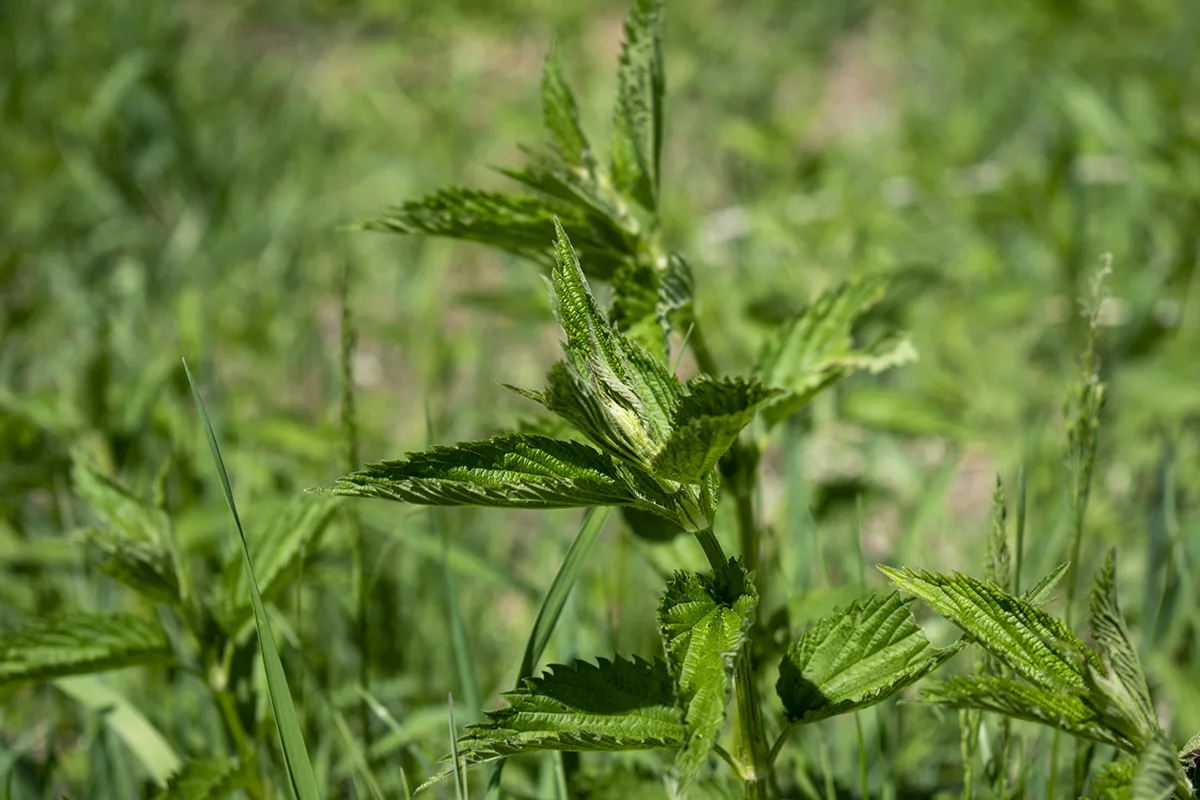
Luckily, it grows practically everywhere. Urtica dioica, common nettle or stinging nettle, is native to Europe but has found its way across the globe.
I could go on and on about the health benefits of eating this plant. Or I could tell you that I dry scads of stinging nettle leaves every spring and then powder them so I can add a scoop to my morning smoothies all year. I could tell you this common weed that grows practically everywhere has more nutrients per gram than any veggie in my supermarket’s produce section. But you’re not here for that.
You’re here for fertilizer. Free fertilizer.
So, let’s talk fertilizer, but just in case I’ve piqued your interest, here are some great ways to use this plant outside of the garden, including stinging nettle soup.
When the snows finally melt, and things begin to green up a bit, you can bet that stinging nettle is one of the first plants easily found each spring.
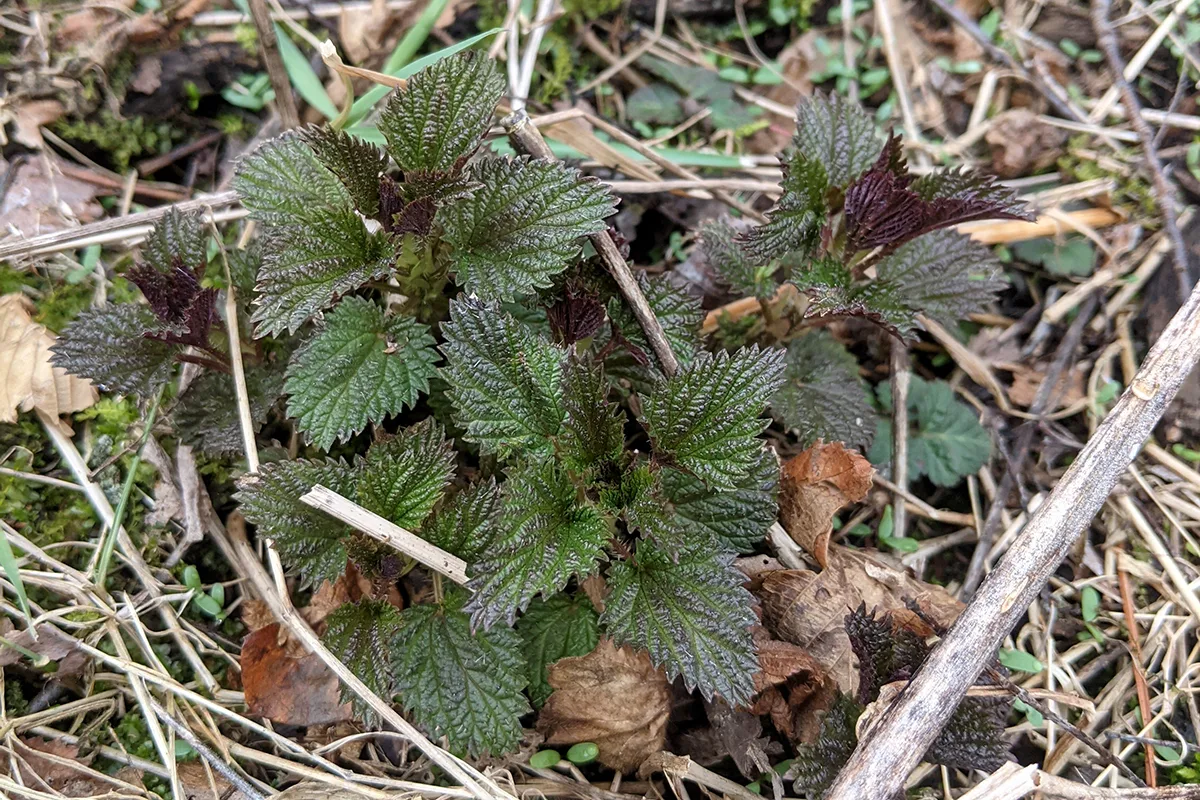
Its crinkled tops first emerge as a deep green with almost purplish undersides. And as it grows, it turns into that fresh spring-green plant hikers avoid.
For gardeners everywhere, the emergence of stinging nettle means it’s time to make a few gallons of stinging nettle fertilizer.
Sometimes known as stinging nettle tea, this smelly but powerful fertilizer packs a real nitrogen punch.
As I already mentioned, stinging nettle is a plant packed with nutrients, vitamins, and trace minerals. It’s a good plant to incorporate into your diet. It’s that kind of thinking that has led the permaculture community to start incorporating these plants into their design and using them to fertilize organic gardens. If all those nutrients are good for us, surely, they’re good for plants too.
What Plants Benefit from Stinging Nettle Fertilizer?
Because stinging nettle fertilizer is high in nitrogen, it’s best used on young plants to help them develop. You can use it on all your plants when they are seedlings and young transplants. However, you’ll want to discontinue using stinging nettle fertilizer for flowering plants once the plants begin to set flowers.
If you keep using a high-nitrogen fertilizer on flowering plants, you’ll have plenty of lush foliage with very few flowers or fruit. For these types of plants, it’s best to switch to a fertilizer that’s higher in potash once those first few flowers appear.
You can keep using stinging nettle for non-flowering plants, such as your brassicas – cabbages, Brussels sprouts, bok choy, and leafy greens like lettuces and arugula throughout the season.
How to Harvest Stinging Nettle
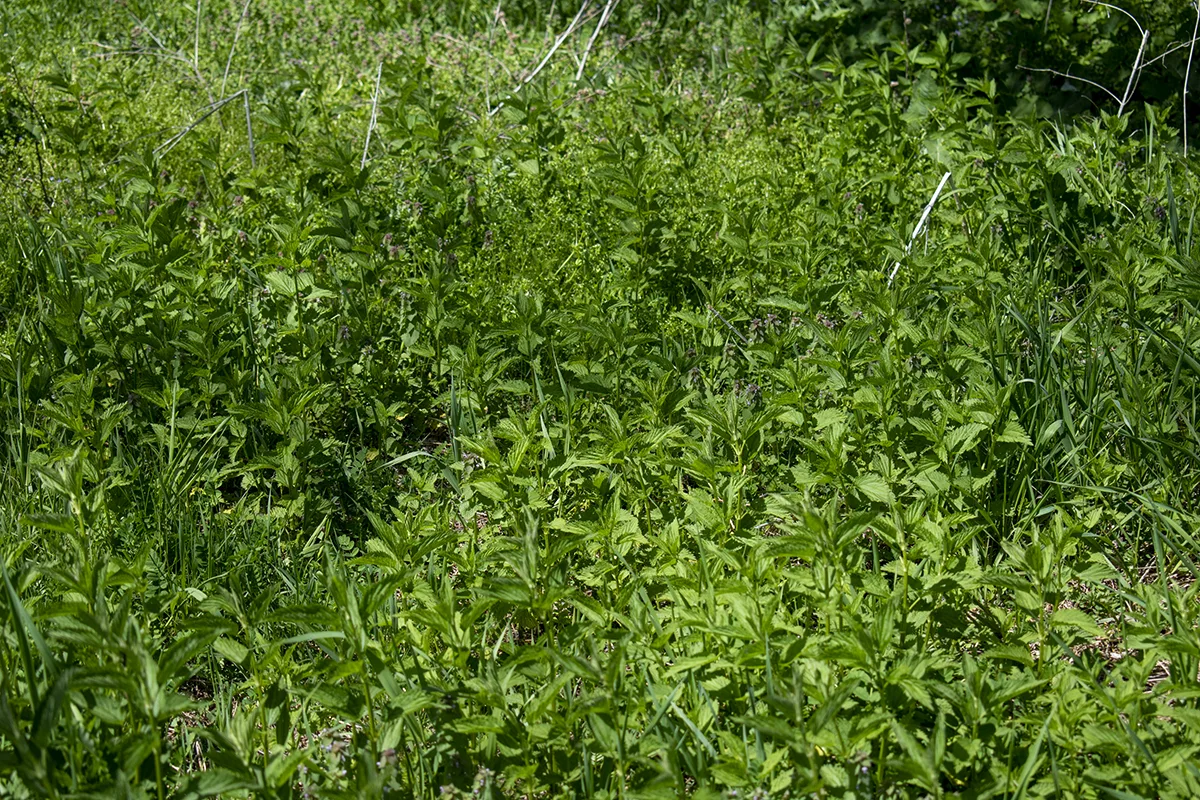
What to Wear
Stinging Nettle came by its name, honestly, and although the rash that accompanies a brush with this plant is harmless in the long run, it’s still no fun. When picking your stinging nettle to make fertilizer, a few necessary precautions will keep you sting-free.
Most plants sporting thorns prick or scratch you if you bump into them with enough force. However, stinging nettles don’t have hard thorns but rather tiny hollow, needle-like hairs. Each of these is full of formic acid. And it only takes a brush against this plant to realize the painful and itchy mistake you made.
Gloves and long sleeves are the way to go when it comes to stinging nettle. If you’re wandering into them, you need to wear pants instead of shorts.
If you have them, a long pair of leather pruning gloves will protect your arms and hands. However, most gardening gloves will do the trick when paired with a long-sleeved shirt.
Gloves made of canvas, leather, or knit-fabric gloves dipped in a nitrile or rubber coating are perfect. I would avoid plain jersey-knit gloves as the fabric isn’t thick enough to prevent penetration of the tiny spines when you’re grasping the plant. (Ask me how I know.)
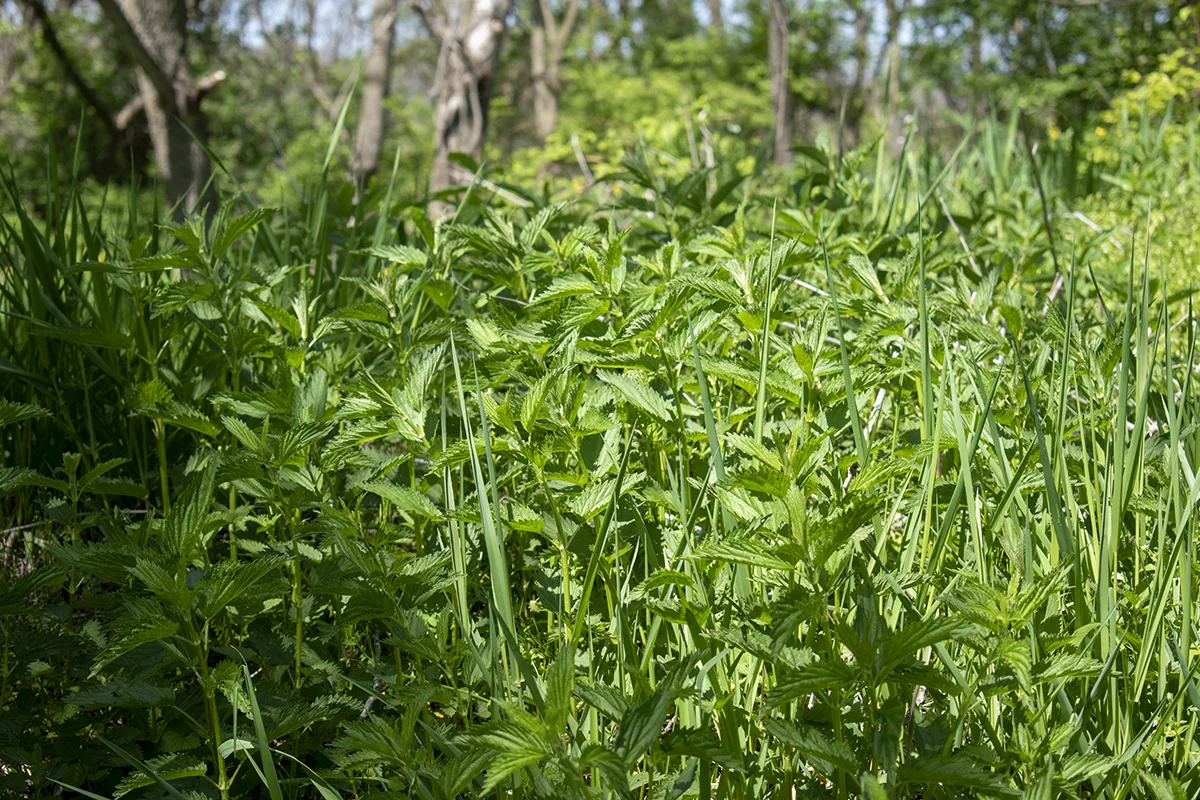
What to Cut Stinging Nettle With
A pair of scissors or small pruners are perfect for snipping the tall, fibrous stalks of stinging nettle. The stems grow tougher as the season wears on, so opt for the pruners if you’re making a batch of fertilizer later in the summer.
Don’t forget to gather a few extra leaves for tea, nettle beer or stinging nettle pesto.
I Got Stung, Now What?
Should you get stung despite your best efforts to avoid it, don’t panic. Chances are, the remedy is growing right at your feet or at least nearby. A couple of well-known weeds will ease the sting of stinging nettle until you can get back to the house.
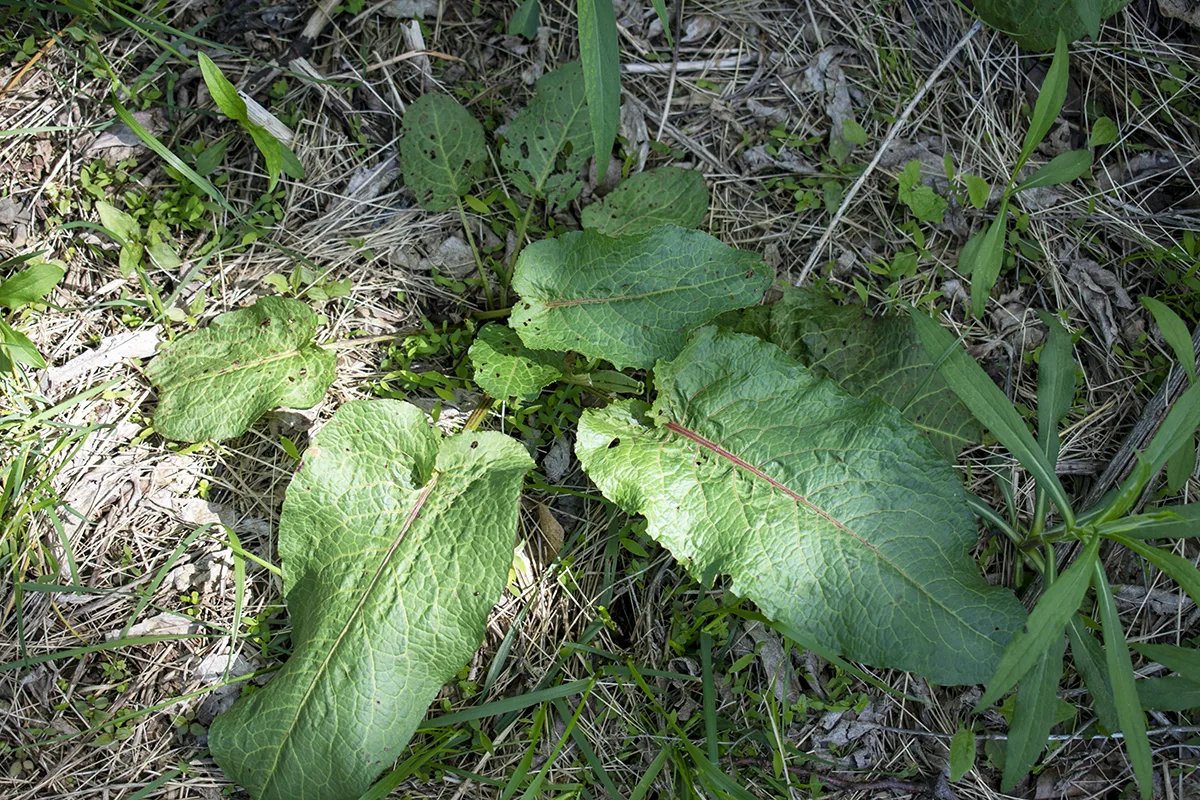
Look for burdock or bitter dock leaves, grab a few, roll them and crush them well in your hands. Now apply the crushed leaf, vein-side down on the affected area and gently rub the sap of the dock onto your skin.
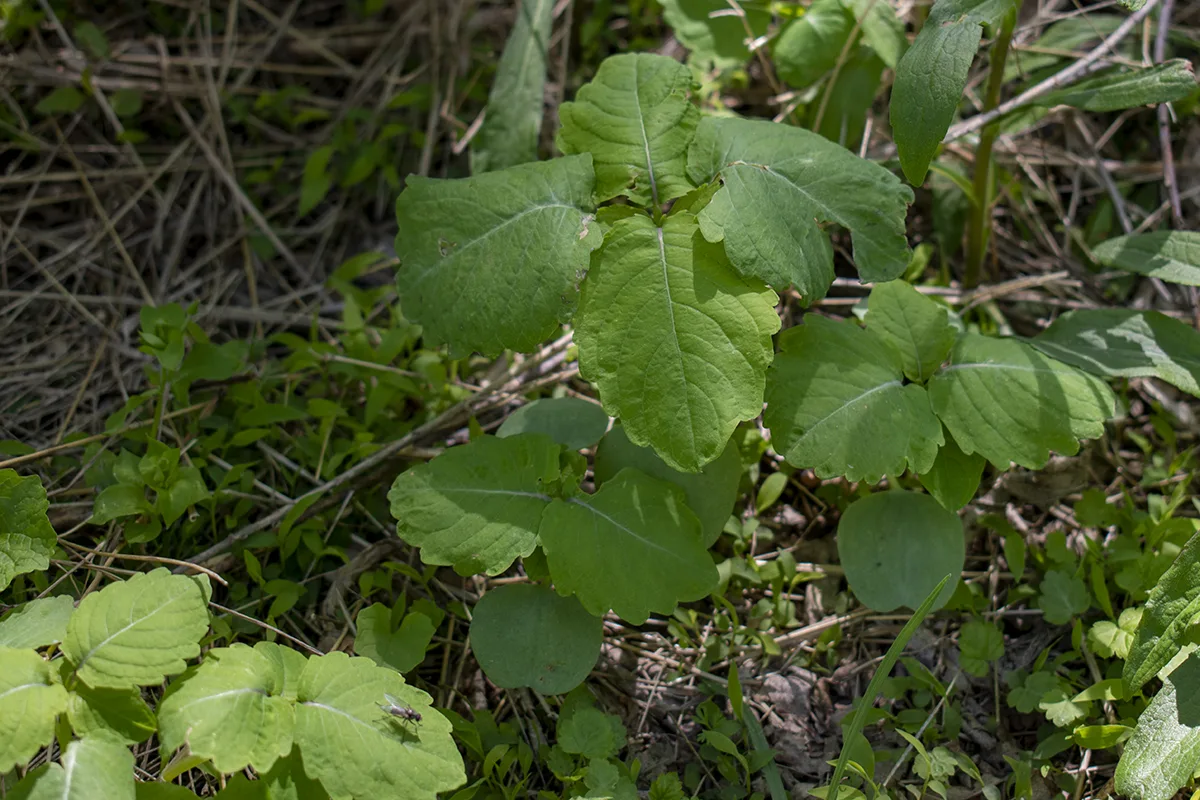
Jewelweed is another easy-to-find weed that will relieve the sting of nettles. Again, you want to apply the sap from the jewelweed to your skin gently.
Luckily, both bitter dock and jewelweed are almost always found where stinging nettle grows.
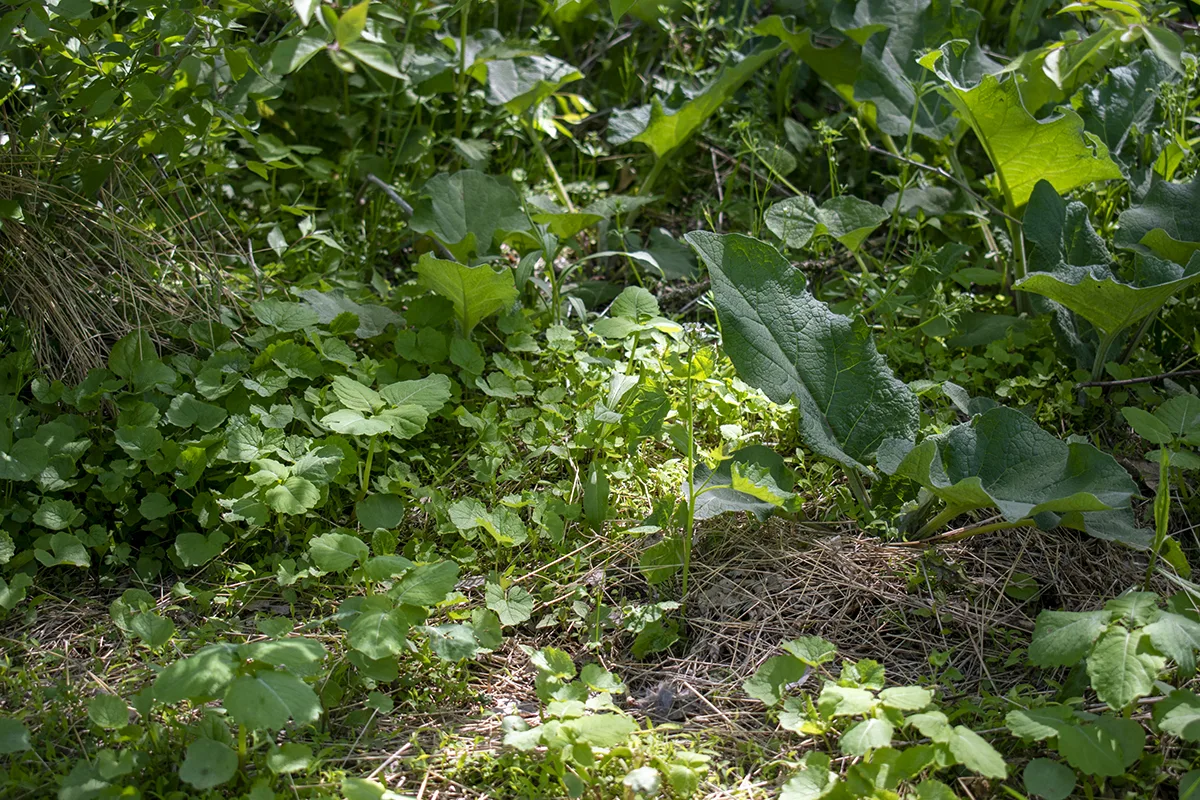
Once home, run the affected body part under cool water and use a damp cloth to gently wipe away the spines embedded in your skin, then wash with a mild soap. Apply an ice pack to relieve some of the inflammation. If needed, you can also use topical antihistamine or corticosteroid creams to relieve the itching.
Getting hit with stinging nettle is no fun, but the misery usually only lasts for a day or two. It’s also a lesson one rarely forgets, so it only happens once.
Be a Responsible Harvester
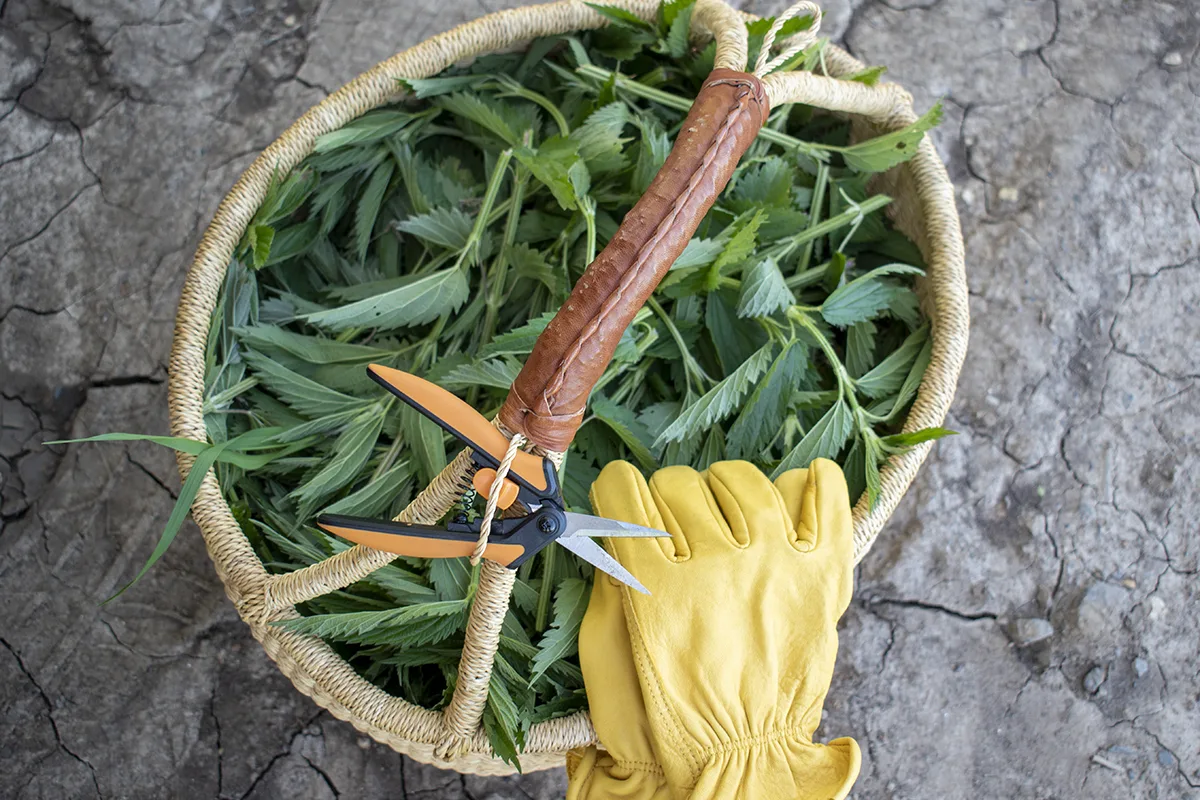
Stinging nettle is home to many beneficial insects we try to attract to our gardens each spring, such as ladybugs, hoverflies, native pollinators, and predatory wasps. Scientists think they hang out on these plants, knowing grazing animals are less likely to munch on them.
Whether in your backyard or from a patch of nettles in the woods, remember to only pick one-third of the plants in that area. We want to be good stewards of our natural resources and remember that we’re not the only ones who rely on them.
Fermented Stinging Nettle Fertilizer Tea
Okay, let’s mix up a batch of free organic fertilizer, shall we?
Mixing Your Brew
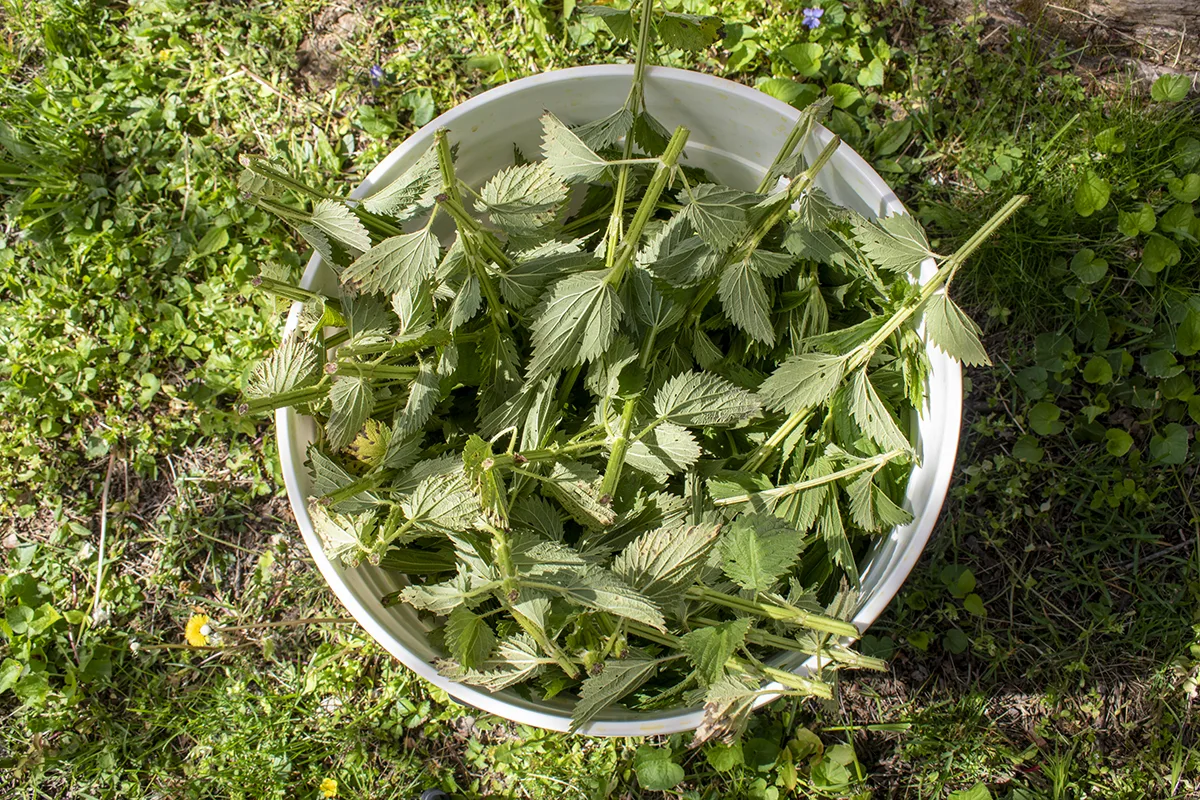
Pick enough stinging nettle to fill a five-gallon bucket to the top.
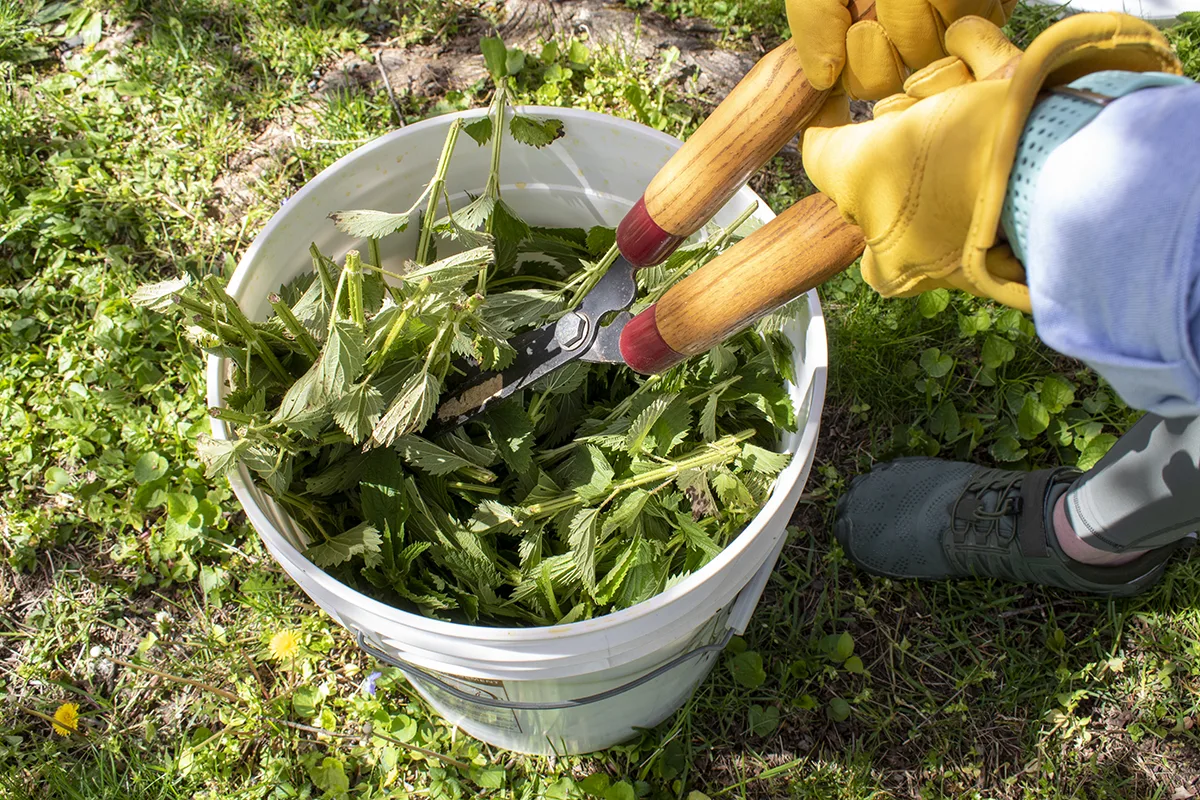
Use a pair of hedge clippers to chop the nettles into a rough mulch. You should have enough nettle mulch to fill the bucket halfway.
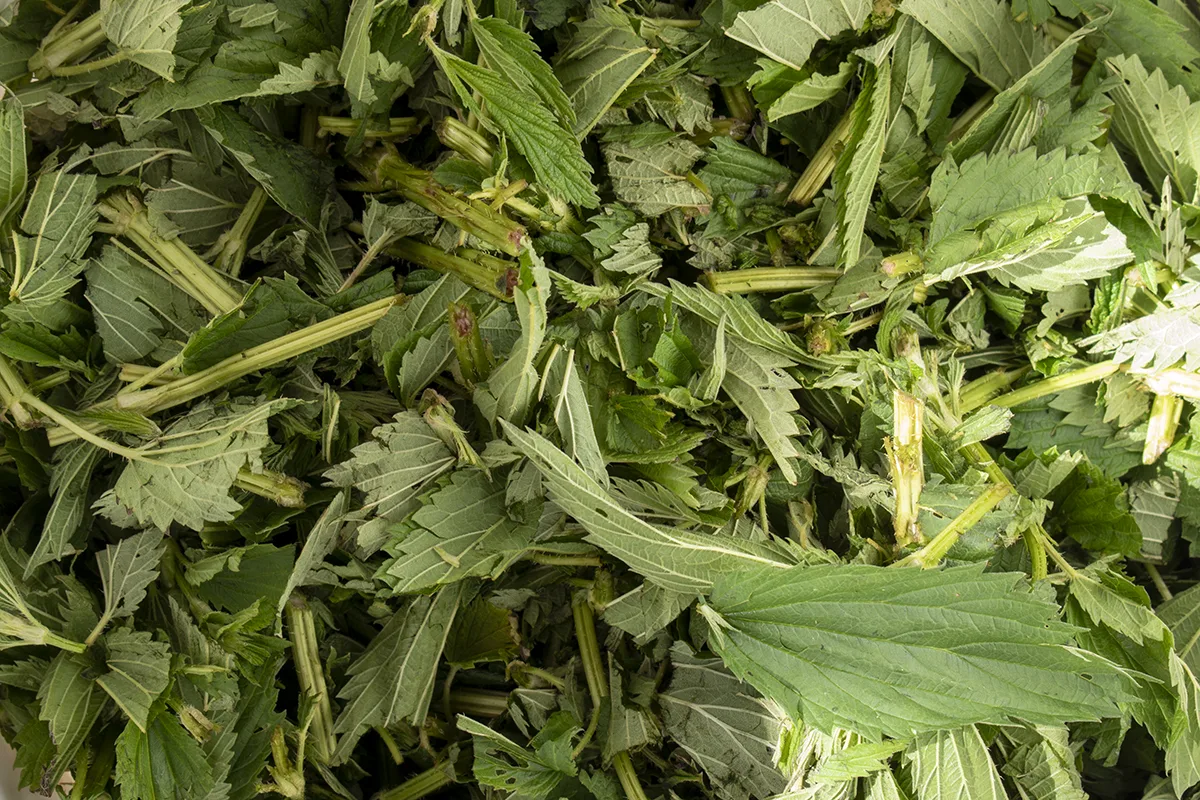
Fill the bucket up with collected rainwater for your fertilizer tea, as it will already have naturally occurring organisms present that will hasten the fermentation process.
Chlorinated water can slow down or even prevent fermentation. If all you have access to is chlorinated water, leave the bucket uncovered for 24-48 hours for the chlorine to evaporate. It may take a few more days for the mixture to begin fermenting when using dechlorinated tap water.
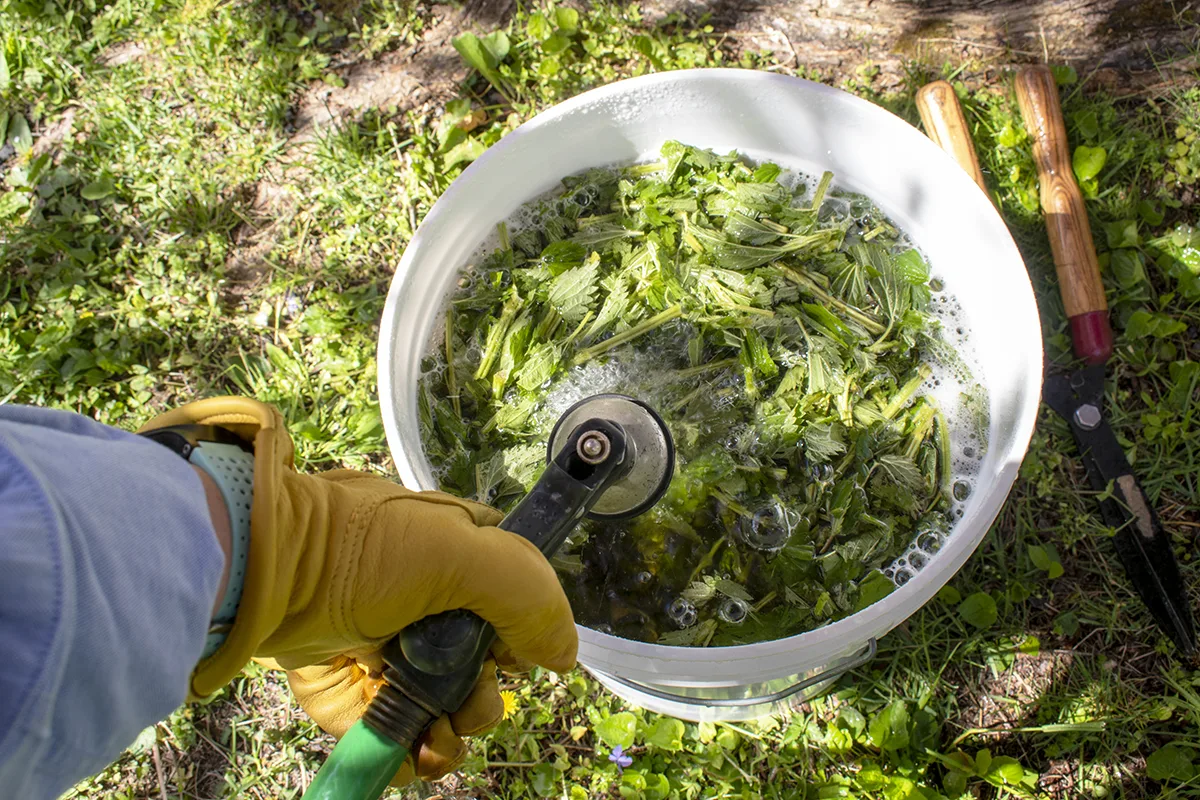
Let it Ferment
Cover the bucket once you’ve mixed up your brew, but don’t seal it tightly. Gasses caused by the fermentation process will begin to build up pressure in a sealed container, which could lead to a very smelly mess.
Stir your fertilizer tea mixture every couple of days. After a few days, you’ll notice the mixture will start bubbling. This is good! This means you’ve got fermentation happening.
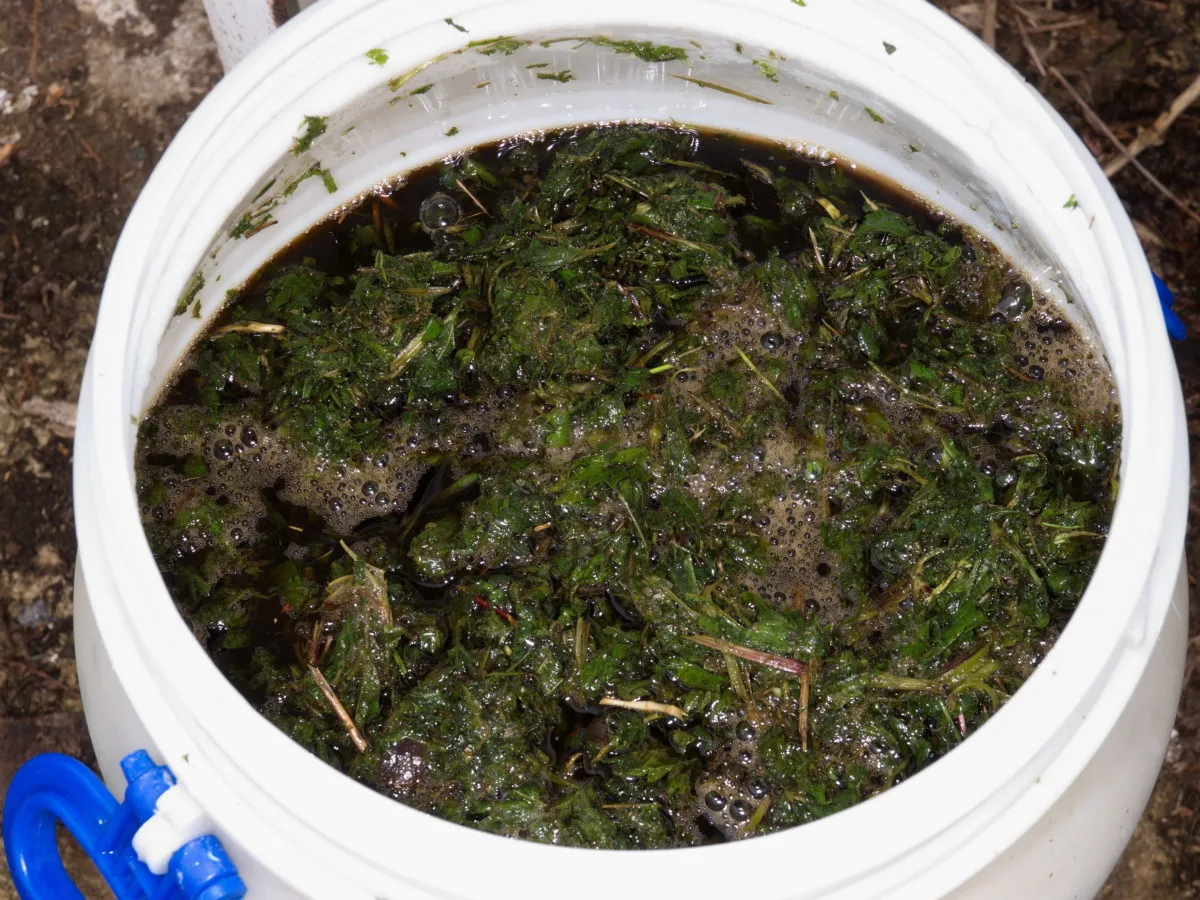
What Is That Awful Stench?
Okay, I’m not going to lie – this stuff reeks. It’s best to set up your bucket somewhere downwind from the house. Maybe put it upwind of the neighbors who let their dog poop on your lawn and never clean it up. Stinging nettle tea is a next-level nose offense. But stick with it because the result is worth it.
After about ten to fourteen days, the mixture will stop bubbling, and you’ll know your stinging nettle fertilizer is finished fermenting.
Straining
Now that your fertilizer tea is ready, it needs to be strained to remove the solids. You can do this using a large screened funnel, cheesecloth, or a fine-mesh strainer to scoop out the solids floating on top.
Don’t throw away that stinky blob of fermented greens! Toss them on the compost pile, where they will continue to decompose and add nutrients to your compost, unless you picked nettle that’s already gone to seed. Adding those to your compost pile will ensure a healthy nettle crop next spring.
Now that you’ve decanted your fertilizer, it’s ready to use.
Liquid Fertilizer
Your concoction is highly concentrated and should never be used full-strength on your plants. Doing so can result in fertilizer burn, damaging tender roots. Always dilute the fertilizer with water in a ratio of 1:10. For example – one cup of full-strength fertilizer to ten cups of water.
Once you’ve diluted the fertilizer properly, apply it directly to the base of the plants, where it can soak down to the roots. Liquid-based feeds are always my favorite as they provide nutrients the plant can use right away.
It’s safe to fertilize with stinging nettle tea every three to four weeks at the 1:10 strength. Anymore and again, you run the risk of fertilizer burn.
Foliar Spray
To use stinging nettle fertilizer as a foliar spray, change the ratio to 1:20, adding one part of fertilizer to twenty parts of water.
Using it in this way gives your plants the added benefit of protection from thrips, aphids and spider mites. (Although I wouldn’t recommend using it on houseplants due to the strong scent.) Plants can absorb nutrients through their leaves as well as their roots, which is why plenty of gardeners prefer to fertilize using a foliar spray.
You may want to filter this solution once more through several layers of cheesecloth before using it, as fine plant matter in the tea can clog the nozzle of your sprayer or spray bottle.
Like most foliar sprays, you should apply stinging nettle fertilizer in the afternoon or evening, once your plants are out of the sun and before the dew falls. As a reminder, you won’t want to use this as a foliar spray on flowering plants once they set flowers.
There’s something pretty great about feeding your plants with an organic fertilizer that didn’t cost you a dime. And you didn’t even have to drive to the garden center to get it. Despite its intense aroma, I feel that once you see the results of stinging nettle tea, you’ll be making a batch each spring.
You may be surprised at the many free fertilizer teas you can make from plants commonly found in your backyard. If you’re tired of rising prices and want to add a bit of self-sufficiency to your garden, give these other liquid fertilizer teas a try, too.

Get the famous Rural Sprout newsletter delivered to your inbox.
Including Sunday musings from our editor, Tracey, as well as “What’s Up Wednesday” our roundup of what’s in season and new article updates and alerts.

